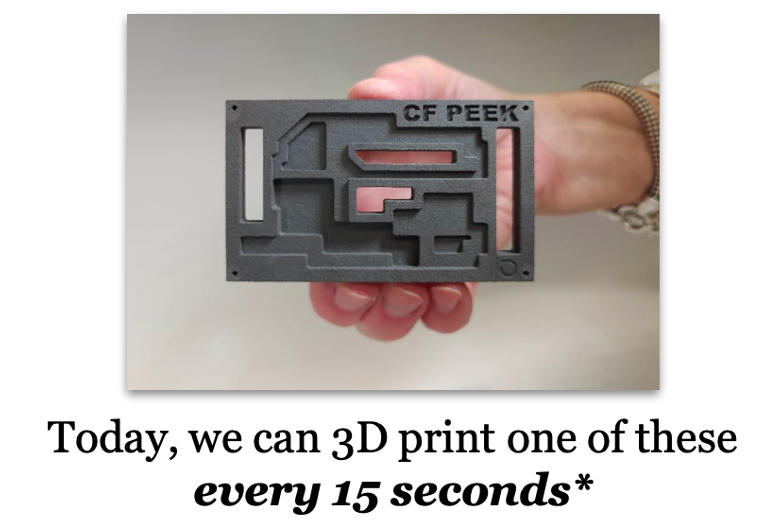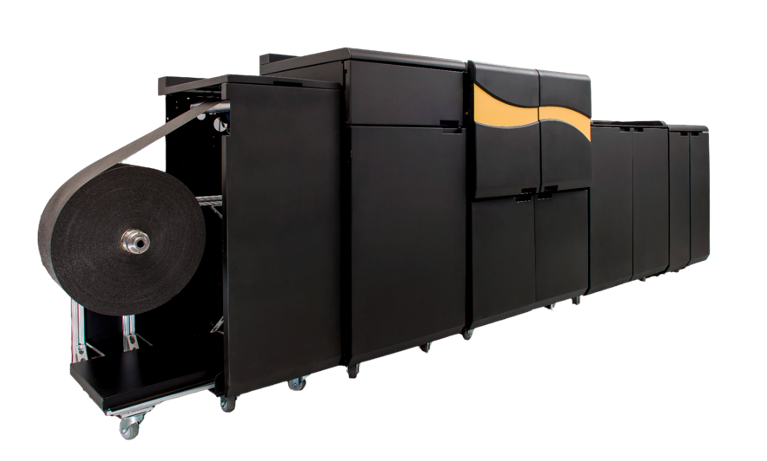As hinted at in our recent interview with CEO Steve Hoover, Impossible Objects has announced the launch of its newest 3D printer, the CBAM 25. To be unveiled at RAPID+TCT, the system is said to print “15 times faster than the fastest competition.”
Impossible Objects’ composite based additive manufacturing (CBAM) technology begins with the deposition of a binder ink onto a sheet of reinforcement material, before a thermoplastic powder coats the substrate, adhering only to the ink. This is repeated with each subsequent layer, resulting in a stack of sheets that must then be compressed and sintered in a furnace, with the binder causing the layers to fuse together. Excess material is then removed, leaving the final composite part.
From the company, it sounds as though the CBAM 25, the follow-up to the CBAM 2 machine, is not only quicker than other composite 3D printers but also faster than other high-throughput machines. Just read how Robert Swartz, Founder and Chairman of the Board at Impossible Objects, phrased it:
“The world is made out of things and with the CBAM 25 we are changing the way they are made. The CBAM 25 is the world’s fastest printer, and we are entering a new era of 3D printing with nearly unlimited material options at the speed of true mass production. This is a Moore’s law moment for 3D printing, and this is just the first step.”

Specifically, the company has compared the speed of its process with selective laser sintering, high-speed sintering, and fused filament fabrication when it comes to the production of a 114 x 28 x 10 mm bell crank. If accurate, Impossible Objects may have, as the firm puts it, “[broken] the 3D printing speed barrier.”

It’s important to note, however, that these numbers do not include post-processing times and, in the case, of Impossible Objects, these times may be significant, given the furnace and material removal steps. However, these other processes typically don’t print with the same type of composites, though they do have their own composite materials. Because CBAM combines rolls of carbon fiber sheets with PEEK, essentially the strongest and most heat- and chemical-resistant polymer in the AM world, components made with the process are surely among the toughest in the sector.
“With a fifteen times speed improvement over existing 3D printers our new CBAM 25 completes the transition of 3D printing from its roots in prototyping to the heartland of manufacturing,” said Impossible Objects CEO Steve Hoover. “It’s hard to actually imagine what fifteen times faster means. For a comparison, this is also the speed difference between the fastest human running the mile and a Formula race car in a straight away. That’s the same difference that our new CBAM 25 has versus prior technologies. We believe that this is a huge-step forward not only for our company, but also our industry, as it moves 3D printing into volume manufacturing.”
The Chicago-area startup has had a tough climb introducing its entirely novel AM technology to the industry. As relayed by Hoover in our interview, it aims to address this issue with a part printing service, which will allow customers to get acquainted with CBAM with the potential of purchasing equipment later on. Now that the CBAM 2025 has been unveiled, with commercial availability slated for early 2024, the offer from Impossible Objects has become that much more attractive.

The CBAM 25.
With carbon fiber PEEK parts as alternatives for aluminum, tooling, spares, repairs and end-use components, it’s likely that larger manufacturers who were once considering the use of CBAM will be that much more drawn to the new system. We can easily imagine users in the aerospace, defense, and transportation industries producing large batches of these parts, disrupting the niche carbon fiber 3D printing segment and more. To learn more, visitors of the upcoming RAPID+TCT Show will be able to visit Impossible Objects at booth #4024.
Images courtesy of Impossible Objects.
Subscribe to Our Email Newsletter
Stay up-to-date on all the latest news from the 3D printing industry and receive information and offers from third party vendors.
You May Also Like
Gorilla Sports GE’s First 3D Printed Titanium Cast
How do you help a gorilla with a broken arm? Sounds like the start of a bad joke a zookeeper might tell, but it’s an actual dilemma recently faced by...
Nylon 3D Printed Parts Made More Functional with Coatings & Colors
Parts 3D printed from polyamide (PA, Nylon) 12 using powder bed fusion (PBF) are a mainstay in the additive manufacturing (AM) industry. While post-finishing processes have improved the porosity of...
$25M to Back Sintavia’s Largest Expansion of Metal 3D Printing Capacity Since 2019
Sintavia, the digital manufacturing company specializing in mission-critical parts for strategic sectors, announced a $25 million investment to increase its production capacity, the largest expansion to its operations since 2019....
Velo3D Initiates Public Offering in a Bid to Strengthen Financial Foundations and Drive Future Growth
Velo3D (NYSE: VLD) has been among a number of publicly traded 3D printing firms that have attempted to weather the current macroeconomic climate. After posting a challenging financial report for 2023,...































